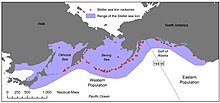
Back أسد بحر ستيلر Arabic اسد بحر ستيلر ARZ Piakudol (Eumetopias jubatus) AVK Şimal dəniz şiri Azerbaijani قوزئی دنیز اسلانی AZB Сівуч Byelorussian Сивуч Bulgarian Morleon Steller Breton Lleó marí de Steller Catalan Eumetopias jubatus CEB
| Steller sea lion Temporal range:
Early Pleistocene – present (~800,000–0 YBP)[1] | |
|---|---|

| |
| Adult male, female and pup on Yamsky Islands in the northeast Sea of Okhotsk | |

| |
Size of male (left) and female (middle) compared to a 1.75-metre (5 ft 9 in) human
| |
| Scientific classification | |
| Domain: | Eukaryota |
| Kingdom: | Animalia |
| Phylum: | Chordata |
| Class: | Mammalia |
| Order: | Carnivora |
| Clade: | Pinnipedia |
| Family: | Otariidae |
| Genus: | Eumetopias Gill, 1866 |
| Species: | E. jubatus
|
| Binomial name | |
| Eumetopias jubatus (Schreber, 1776)
| |

| |
| Range of Steller sea lions (purple = overall range, red = breeding rookeries) | |
The Steller sea lion (Eumetopias jubatus), also known as Steller's sea lion or the northern sea lion, is a large, near-threatened species of sea lion, predominantly found in the coastal marine habitats of the northeast Pacific Ocean and the Pacific Northwest regions of North America, from north-central California to Oregon, Washington and British Columbia to Alaska. Its range continues across the Northern Pacific and the Aleutian Islands, all the way to Kamchatka, Magadan Oblast, and the Sea of Okhotsk, south to Honshu's northern coastline. It is the sole member of the genus Eumetopias, and the largest of the so-called eared seals (Otariidae). Among pinnipeds, only the walrus and the two species of elephant seal are bigger. The species is named for the naturalist and explorer Georg Wilhelm Steller, who first described them in 1741. Steller sea lions have attracted considerable attention in recent decades, both from scientists and the general public, due to significant (and largely unexplained) declines in their numbers over an extensive portion of their northern range, notably in Alaska.
- ^ Tsuzuku, Nahoko; Kohno, Naoki (27 August 2020). "The oldest record of the Steller sea lion Eumetopias jubatus (Schreber, 1776) from the early Pleistocene of the North Pacific". PeerJ. 8: e9709. doi:10.7717/peerj.9709. ISSN 2167-8359. PMC 7456534. PMID 32913674.
The mandibular fossil (GKZ-N 00001) from the lower Pleistocene Omma Formation (0.8 Ma) is specifically identified as E. jubatus based on the morphometric analyses.
- ^ Gelatt, T.; Sweeney, K. (2016). "Eumetopias jubatus". IUCN Red List of Threatened Species. 2016: e.T8239A45225749. doi:10.2305/IUCN.UK.2016-1.RLTS.T8239A45225749.en. Retrieved 19 November 2021.
- ^ "NatureServe Explorer 2.0". explorer.natureserve.org. Retrieved 11 October 2022.

